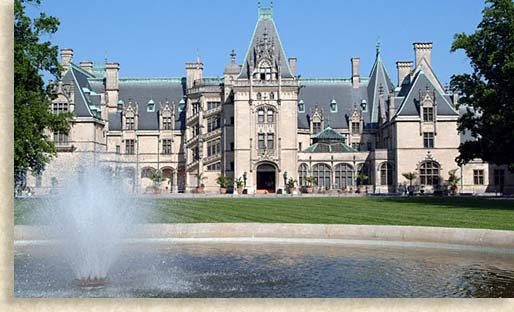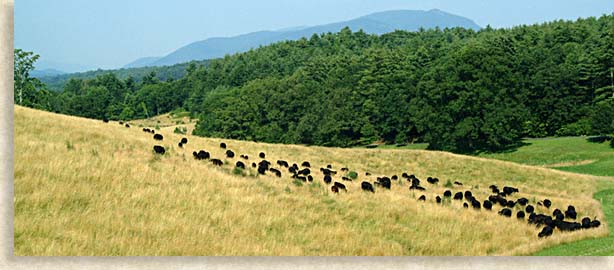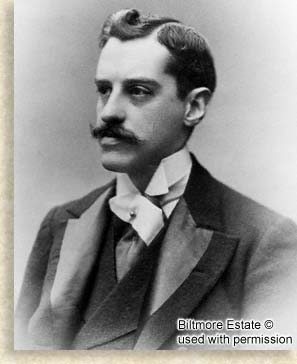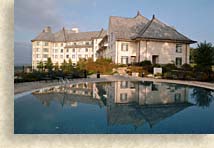
During his life at Biltmore Estate George Vanderbilt focused on beauty, grandeur and self-sufficiency. He saw the surrounding forest as an agriculture enterprise and amassed 125,000 acres of forest and farmlands.
Mr. Olmsted teamed up with Gifford Pinchot, the first American-born, trained forester to practice in the United States. Olmsted initiated the comprehensive land management program. Pinchot proposed a way to turn the ravished landscape and patchy forest into a productive timberland. His was the first planned forestry program in America. Pinchot began the estate’s plan for rehabilitation of the woodland in 1891 by identifying varieties, selectively thinning and planting for maximum timber yield. This plan served as a national model for the US Forest Service after Pinchot left Biltmore in 1895.
Dr. Carl Schenck a prominent German forester took over the estate’s forest, founded and ran the Biltmore Forest School from 1898 thru 1913.
In 1915 Mrs. Edith Vanderbilt sold nearly 87,000 acres of forest to the federal government creating the nucleus of Pisgah National Forest, she did this to honor George’s wish to preserve his forest for the public's enjoyment.

Today Biltmore Estate maintains 7,000 acres with approximately 4,500 acres of planted forests, the timber is harvested and sold to provided some financial support for the estate. The cost of running Biltmore Estate is staggering with as many as 1,500 personnel, plus expenses. It is the continuation of George’s self-supporting dream that has helped allow such a vast estate to remain privately owned and in the hands of his family.
George and Edith Vanderbilt’s only child Cornelia Vanderbilt Cecil opened Biltmore Estate to the public in 1930 at the request of the city of Asheville. She did so to boost tourism in the region during the Depression Era.
During World War II priceless artworks from the National Gallery of Art were stored at Biltmore House for safe keeping, to protect them from a possible air attack on the nation's capital.
The estate today remains as it was planned, and awe-inspiring experience, a monumental structure amongst the natural and enhanced beauty of nature. Since the first day George committed to his dream, this unique place has been everything George envisioned. It’s a wonderland that will live beyond expectations, growing in its uniqueness, reaffirming itself continually as an American legacy. Biltmore Estate was conceived and developed during the Gilded Age, a time in American history that appeared to be drenched in milk and honey.
Monuments like the Biltmore House help us define who we were as a young nation…strong innovative, driven to believe, always pushing the fabric of life and art to the very edge.
For nineteen years George lived his dream …he was Lord of the Manor and King of a Wilderness Empire. George and Edith helped build schools, churches and hospitals. They purchased a nearby town on the edge of the estate and changed its name to Biltmore Village to create a community for their many employees to live. Biltmore Estate shares its soul with the many who visit, the soul of a man and his vision.
In March 1914 George was rushed to the hospital in Washington D.C. for an emergency appendectomy, the trip proved fatal. So ended the life of George Washington Vanderbilt. Mr. Vanderbilt was buried in the family mausoleum on Staten Island, New York. George likely set out on a shooting star, seeking greater heights in another dimension beyond the plain of known reality.
At the closing of the Gilded Age, men like the Vanderbilt's, who helped pioneer the industrial revolution lost their opportunity to express themselves in bigger than life achievements. Many of these men’s treasures and achievements have been left behind, like large footprints in the sand, another step towards a greater tomorrow. There will never be another George Vanderbilt, there will never be another Biltmore Estate, only the opportunity for you to come and experience George Washington Vanderbilt's personal 19th century dream.
 George Washington Vanderbilt |
Mountains rise above the mist of moors Skies of color shield the valley floor His vision casts light upon a canvas' breadth In a world of wonder he found wings and soared Curtains thrown back, doors flung open, his imagination has prevailed Within these hallowed halls his thoughts reside Manifesting the dreams of his heart's desire |
The Highlander
 |
The Highlander Slept Here...Inn on Biltmore Estate |
![]()
Sign
up for the Blue Ridge Highlander Newsletter, Messages from the Mountains
to find out first about our new feature stories, road trips and special offers
Your e-mail addresses will not be sold or given away to anyone.
Privacy
Policy
Interested in your business being on the Highlander, click here...
Let our visitors tell you about the Highlander...
Click the feathers to go to the Highlander site
map...


